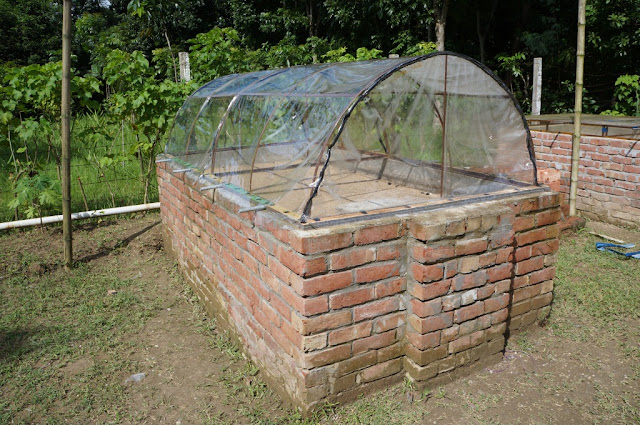Wednesday 28th August
We traveled down to the site at Faridpur this morning, and as
it is a public holiday, the streets were relatively clear. We made it to the Faridpur Muslim Mission
(our overnight hosts) by lunchtime, and had time to freshen up and have a bite
to eat before heading over to the site.
 |
| Views from the ferry |
 |
| This is the kind of ferry we were on - classic roll-on/ roll-off type. |
 |
| This is the Padma River - just after the Ganges and Brahmaputra converge in the middle of the country - and its huge (takes at least 45mins to cross by ferry) |
 |
| Snacking on guava |
It later turned out that we had been lucky to get across so smoothly - one of our colleagues at Practical Action had been delayed for several hours the day before, as one of the ferries had grounded. This is an increasingly severe problem, as the rivers (all 24,000km of them) in the country are silting up, and dredging is an expensive and time consuming process.
The Faridpur Muslim Mission is an orphanage, vocational
training centre and guesthouse, and the rooms are clean and tidy, and the staff
kind and helpful, though the electricity supply is somewhat variable.
|
|
I got to site and had a big smile on my face – the new ‘polytunnel’ roofs are just what we had been thinking of at the outset of the
project, although the team here have added some great touches, like zippered closures and velcro tabs to stop the sides blowing out.
|
|
Practical Action have also created a little demonstration growing bed, where half the soil is mixed with composted sludge from phases 1 and 2, and half is plain. They’ve planted various crops in these beds, and hope to show the productivity of the earth with its new additive:

Unfortunately the team planted different crops in each
quadrant, limiting the amount of direct comparison we could do, but I’ve urged
them to repeat the trial with the next set of compost generated, and plant the
same crops across the beds, so we can directly see any improved growth.
The reedbed has grown up and flowered, and they’ve put some fish in the polishing pond, and some examples of the Bangladesh national flower.
 |
| The reedbed has grown up since my last visit |
Another example of the nice touches that are happening at
site are the potted planted along the entrance to the new office. I’m not saying they wouldn’t have done this
had I been male, or had there not been a lady working on the project at
Practical Action who thought of it, but….it’s a lovely gesture and does give the
place a homely feel.
We noted a couple of lessons in terms of material use - under prolonged sunlight/ heat the polycarbonate sheet of one of our old roofs had become so brittle, that a few weeks earlier someone had put a bottle on top of it and the sheet shattered:
 |
| The Site Office |
Similarly the roof we painted back in Phase 1 of tests is now peeling:
As the project progresses, its always a good reminder to see these impacts over the long term (its 10 months since the construction phase started) and consider the sustainability of any design we develop or recommend.
It also highlights the choice we are so often faced with between cheap/ quick/ short-lifespan vs expensive/ slow/ long-lifespan.
The weather station was at a crazy angle, so we've taken it down, checked it over and repositioned it on the short pole you can see on the right - should also give a better sense of temperatures at ground level.
 |
| Repositioning the weather station |
On cue, it started raining in the afternoon - you can see the need for roofs!
I also spotted our handyman/ labourer making rope from jute fibres - repeatedly twisting them together until the desired thickness was achieved:
With all the water around, we don't seem to have many mosquitos, but we do have a lot of dragonflies and butterflies flitting around the site. I managed to get a photo of one with transparent wing patches:
 |
| (Apologies for lack of focus on this one - but you can see the wingtip highlighted against the grass) |
My next post will be about the sludge delivery.












No comments:
Post a Comment